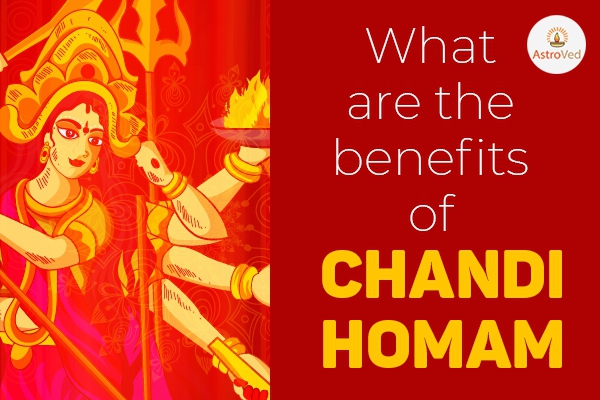What are the benefits of Chandi homam?
Introduction to Chandi Homam:
Chandi Homam is a sacred Fire Lab (Homam) dedicated to the fiercest form of the Goddess Shakthi as Chandi. She is the embodiment of the Trimurti Goddesses Lakshmi, Goddess Saraswathi, and Goddess Parvati. This powerful Homam is used for the removal of all obstacles in life, relief from negative forces, and victory in all ventures.
According to the Markandeya Purana, Devi Mahatmya is a 700-line poem glorifying the Goddess and her victory over dark forces. Devi Mahatmyam is also known as the Durgā Saptashatī or simply Saptashatī (saptashata - "seven hundred")

Significance of Chandi Homam:
The goddess Chandi is a powerful and fierce deity. She is the primordial power that is responsible for the cycle of creation, maintenance, and destruction of the entire universe and is the sum of all energies in the Universe. This Chandi Homam should be performed by those individuals who seek freedom from the negative influences in their horoscope and those who suffer from the afflictions of planetary positions in their horoscope. The Goddess is like a mother who cares for her children, and those who invoke her blessings take refuge in her strength and courage to have a victorious life.
When is Chandi Homam performed:
This Homam is considered as one of the essential rituals in Hindu belief. It is performed across India during the Navaratri festival. It is also performed on auspicious days like Ashtami (8th Moon phase), Navami (9th Moon phase), Chaturdasi (14th Moon phase), Magha Amavasya (New Moon in the month of Magha ( Mid Feb- Mid March), Jyestha Amavasya (New Moon in the month of Jyestha ( Mid-June- Mid July), Chitra ( Mid-April- Mid May) and Karthigai (Mid Nov- Mid Dec)Pournami (Full Moon). It is best to perform this Homam during the daytime and complete it before sunset.
Rituals for performing Chandi Homam:
The devotee should observe a strict fast on the pooja. If this is not possible, a partial fast can be observed by consuming only saatvik food (pure and clean food). Many devotees perform this pooja in a temple as it requires a learned priest (pandit) to recite the verses correctly and in a sequential order, as given below.
Ganapathy Pooja (Ganesha Ritual): Prayers are offered to Lord Ganesha to seek his blessings before any auspicious ritual.
Kanya Pooja (Young Girl Ritual): Kanya Pooja symbolizing the Kanya Kumari (prepubescent) form of Goddess Chandi, is specially performed to recognize the divine feminine power vested in a girl child.
Anugna Sankalpam : Seeking the consent of the Goddess to perform the Grand Homa, which is a sacred ritual.
Punyahavachanam Pooja (Purification Ritual): This ritual is performed to purify the priests, place, and participants of the homa.
Kalasa Sthaapana: Kalasa (pot) filled with auspicious ingredients is used to invoke the blessings of the Goddess.
Devi Mahatmyam Parayanam: Chanting of Durga Saptashati in praise of the Goddess who restored the balance of the universe.
Gho Pooja (Cow Ritual): A ritual and prayers are offered to the holy cow seeking her blessings for prosperity.
Suhasini Pooja (Married Women Ritual): Worshipping an elderly married woman (whose husband is alive) by performing Padha (traditional foot-washing ceremony), Pooja can invoke blessings to relieve from the curses from ill-treating women.
Dampathi Pooja (Couple Ritual): Dampathi means a couple. Prayers are offered to an elderly couple with Padha Pooja can invoke long-lasting relationships and family union blessings.
Brahmachari Pooja (Unmarried Man Ritual): A Brahmachari is an unmarried man, and he is held in high esteem in Vedas and Puranas. Padha Pooja and prayers are offered to a Brahmachari seeking their blessings, which can remove past life curses from learned Vedic Pandits and Gurus.
Chandi Homa (Fire Lab): The fire ritual is performed with the chanting of Mantras and Slokas.
Sumangala Dravyaahuti (Sacred Offerings): Auspicious materials such as Saree, turmeric, sandalwood powder, kumkum (vermillion), etc. are offered to the Goddess invoked in the Fire.
Purnaahuti (Grand Finale Offering): A homa only becomes complete only when this ritual is performed. A cloth bag containing sacred items is dropped into the fire seeking the blessings of the Almighty.
Maha Deeparadhana (Light and Sound Ritual): Light and sound rituals are used to glorify the Goddess and take her blessings.
Benefits of performing Chandi Homam:
Obstacles and curses eliminated from the horoscope of a person.
Blessings of health, wealth and prosperity
Liberation from the evil eye, bad luck, and black magic
Victory over enemies Helps cure any serious bodily ailments
Helps correct any undesirable effects from Dosha
Relief from pain and suffering
Fulfills any wishes
Helps attain salvation
Provides forgiveness and atonement of sins



















